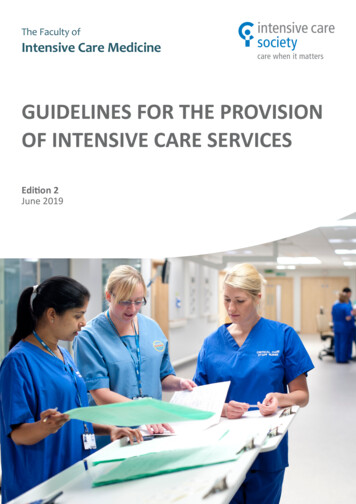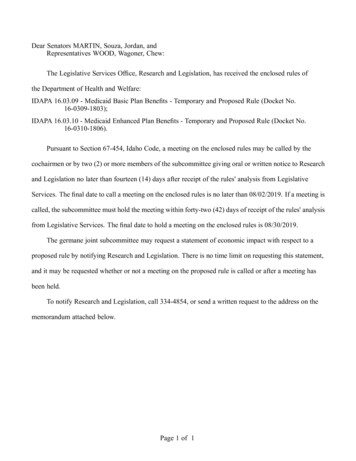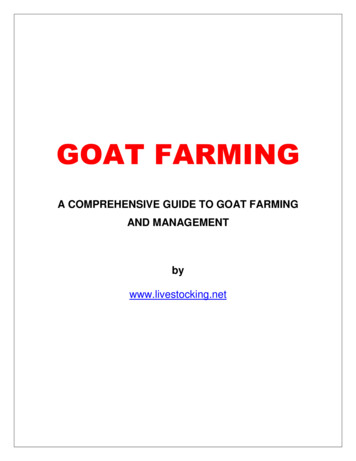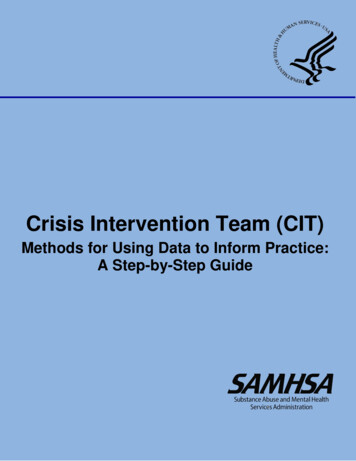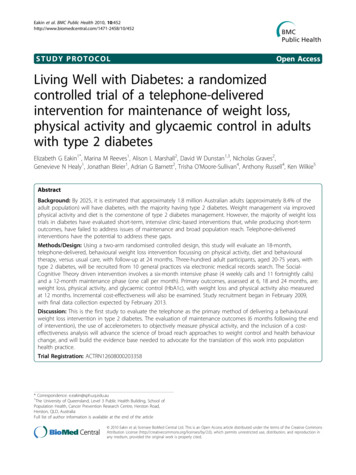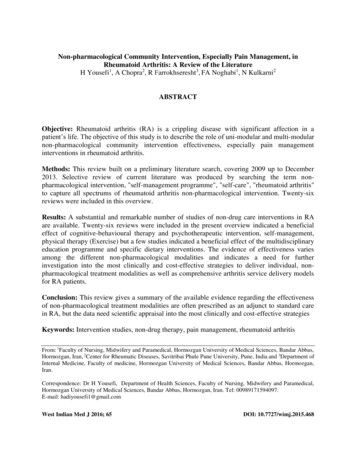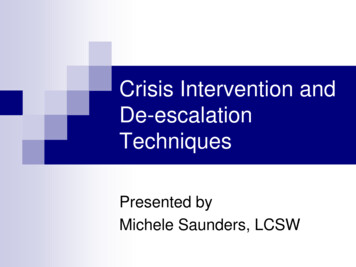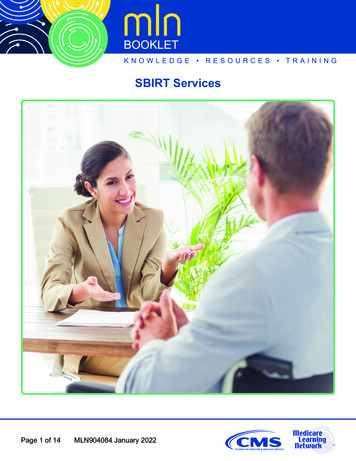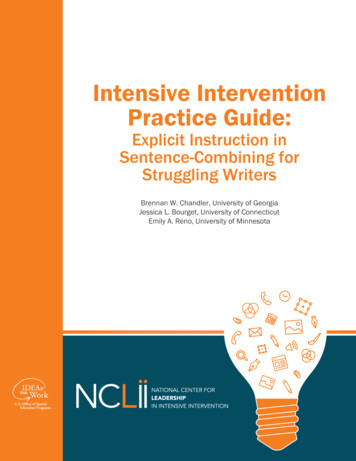
Transcription
Intensive InterventionPractice Guide:Explicit Instruction inSentence-Combining forStruggling WritersBrennan W. Chandler, University of GeorgiaJessica L. Bourget, University of ConnecticutEmily A. Reno, University of Minnesota
Explicit Instruction in Sentence-Combining for Struggling Writers: A Practice Guide 2This project was supported in part by Grant H325H190003 from the U.S. Department ofEducation, Office of Special Education Programs (OSEP). Opinions expressed herein are those ofthe authors and do not necessarily represent the position of the U.S. Department of Education,and no official endorsement by it should be inferred.This product is public domain. Authorization to reproduce it in whole or in part is granted. Althoughpermission to reprint this publication is not necessary, the citation should be: Chandler, B.W.,Bourget, J.L., & Reno, E.A. (2021). Practice Guide: Explicit Instruction in Sentence-Combining forStruggling Writers. Washington, DC: US Department of Education, Office of Special EducationPrograms.Fall 2021Graphic services supported in part by EKS NICHD Grant #1P50HD103537-01 to the Vanderbilt Kennedy Center.
Explicit Instruction in Sentence-Combining for Struggling Writers: A Practice Guide 3ContentsWhat Is It?. 4For Whom Is It Intended?. 5How Does It Work?. 5How Can Families Support Implementation?. 9How Adequate Is the Research Base?. 10How Practical Is It?. 11How Effective Is It?. 12What Questions Remain?. 14Where Can I Learn More?. 15Table 1. 16Table 2. 17References. 19
Explicit Instruction in Sentence-Combining for Struggling Writers: A Practice Guide 4What Is It?In this Intensive Intervention Practice Guide we investigate current practices used to provideexplicit instruction in sentence-combining for struggling writers. Sentence-combining is a practicefor teaching students how to write clear, grammatically correct, and syntactically complexsentences. Students are taught to consolidate information from two or more “kernel” sentences(simple sentences with no modifiers that can be combined) into a single sentence using all theinformation provided, eliminating any redundancies without altering the meaning provided in thesimple sentences (Goodrich et al., 2020). This activity allows students to exercise greater controlover syntax (i.e., the arrangement of words and phrases) by increasing their use of complex clausestructure (e.g., coordinating, subordinating clauses) and conjunctions. Sentence-combining ismost effectively taught using explicit instruction.Explicit instruction is a methodology for teaching characterized by supports that guide studentsthrough clear objectives and rationales for learning, demonstrations of the objective, andsupported practice with regular feedback until mastery of the skill has been achieved (Archer& Hughes, 2011). The general outline of a lesson guided by the principles of explicit instructionhave the following six teaching functions: (1) review, during which relevant previous learningis reviewed; (2) presentation, where lesson goals and important vocabulary is introduced withmodeling procedures; (3) guided practice, during which students practice the skills they havebeen taught with timely feedback from a more proficient person (e.g., teacher, parent); and (4)independent practice, where students practice learned skills on their own until the skills areautomatic (Archer & Hughes, 2011). In addition, explicit instruction includes segmenting orbreaking down complex tasks into smaller, more manageable chunks, making key informationexplicit by using modeling and think-aloud techniques, promoting engagement by systematicallyfading supports as students demonstrate accuracy, frequently eliciting student response andproviding feedback, and creating purposeful independent practice activities that help studentsretain and generalize new knowledge (Hughes et al., 2017). Specific steps for implementing asentence-combing intervention using explicit instruction will be provided in the How Does it Work?section of this practice guide.
Explicit Instruction in Sentence-Combining for Struggling Writers: A Practice Guide 5For Whom Is It Intended?Sentence-combining interventions are intended for students who struggle with writing, rangingfrom elementary-aged to middle school students. Students in upper elementary grades areoften the target of sentence combining interventions as this is the age when many children areidentified as late-emergent poor readers who struggle with general language comprehension andsentence comprehension (Balthazar & Scott, 2019). Sentence-combining is also cited in researchand used with students who have language-based learning disabilities (i.e., developmentallanguage disorder and learning disabilities), struggling writers (i.e., those at-risk for languagebased learning disabilities; Bathazar & Scott, 2018; Saddler et al., 2008), and emergent bilingualstudents (Sjolie, 2006).Students with learning disabilities generally produce sentences that are less complex, includemore spelling and grammatical errors, and have less diverse vocabulary than their same-agepeers (Saddler et al., 2018). Scott and Balthazar (2018) suggested that knowledge of complexsentence structure is essential for academic success and sentence combining may be usefulfor both assessment and intervention with students at risk for learning disabilities. Frequentsentence-combining sessions using explicit instruction with clear modeling and practice allowsstudents to explore language without the added cognitive burden of generating their ownsentence (Saddler et al., 2018).How Does It Work?There are a variety of ways that students can engage in sentence-combining exercises, but it ultimately depends on the goal of instruction. Students can learn pronoun, comma, conjunction, andadjective placement through combining sentences. Furthermore, compound subject and possessive noun production can be taught through this effective supplemental practice (Saddler, 2005).Step 1: Determine Target SkillTo teach sentence-combining, teachers first need to choose a grammatical skill they want totarget (e.g., adjective placement, possessive nouns). Although there is no definitive order of skillsfor sentence-combining exercises, teachers can start with a more scaffolded approach dependingon the skill level of the students (Saddler, 2005). A good way to determine which skill to focus onis to analyze samples of students’ writing. For example, if a student uses short, choppy simplesentences, adjective and adverb placement would be a good place to start. See Table 1 for apossible sequence of sentence-combining exercises.
Explicit Instruction in Sentence-Combining for Struggling Writers: A Practice Guide 6Step 2: Develop a Set of ExercisesAfter a skill is chosen, teachers will need to create sentence-combining exercises. These exercisescan be developed from a variety of curriculum materials, such as social studies and sciencecurriculum; further, short narrative stories also provide material for inspiration. Creating exerciseswithin the context of the curriculum helps both supply and reinforce content knowledge (Grahamet al., 2020). Although explicit writing instruction should take place within core English languagearts (ELA) instruction, writing instruction can take place within content-areas in order to improveoverall writing abilities and to increase comprehension of topics taught during content-areainstruction (Graham & Hebert, 2010).Once content is chosen, teachers can begin to create simple sentences (i.e., kernel sentences).To generate exercises, two guidelines (Strong, 1986) are recommended. First, exercises shouldbe set up so that the base clause comes first, followed by one or more modifying sentences.For example, “the lion roared” could be a base sentence and “the lion was yellow” could bea modifying sentence. The combined sentence would be “the yellow lion roared.” The nextrecommended guideline is to use clues to focus students on the information they need to keepfrom the modifying sentence(s). The first clue teachers can use are underlined words in themodifying sentence:The students played during recess.The students were happy.These kernels resulted in:The happy students played during recess.Teachers can also enclose parenthetical words at the end of modifying sentences:The teacher spilled coffee on her shirt.She forgot to put the lid on. (because)These kernels would result in:The teacher spilled coffee on her shirt because she forgot to put the lid on.After students have ample scaffolded practice with using the clues, teachers can remove theclues so that the students must decide what important material in the modifying sentence needsto be included within the combined sentence. Additionally, teachers can create more than twokernels once students are fluent in their ability to combine two simple sentences (see Saddler &Saddler, 2009).
Explicit Instruction in Sentence-Combining for Struggling Writers: A Practice Guide 7Step 3: Teach ExplicitlyAfter a set of exercises are developed, teachers should employ an explicit instructional format(Archer & Hughes, 2011) to directly teach students how to combine sentences. Before teachersmodel the sentence-combining activity, they can inform students that the activity will help themwrite more interesting sentences that sound better to readers. They can further explain that goodwriters often rearrange, add, and sometimes remove parts of their sentences to make them soundbetter.ModelBefore modeling the sentence-combining process, it is important that teachers pre-teach anycontent-specific vocabulary that will appear in the exercises (Goodrich et al., 2020). For example,the word migrant could be pre-taught with a simple definition, example, and non-example. SeeArcher and Hughes (2011) for an effective scaffolded framework for vocabulary instruction.Before students engage in sentence-combining, it’s important that teachers explicitly model howto combine sentences. During modeling, teachers should provide instruction in clear, consistent,and concise language. Teachers can start with two simple sentences and model through an overtthink-aloud, which gives students access to the self-questions, self-instructions, and decisionsthat occur as exercise is completed. Here is an example:I have two sentences that I need to combine: “Cesar Chavez was a migrant. Cesar wasbrave.” The first sentence tells me that Cesar was a migrant and the second sentencetells me that he was brave. I can move the word “brave” to the first sentence; I don’tneed the words in the rest of the sentence anymore. I am going to write it like this: “CesarChavez was a brave migrant.” I think that sounds good! The word “brave” describesCesar, and I used all of the information from the two sentences. Now I need to writethe new sentence. (Teacher writes sentence, saying each word out loud while writing). Idon’t know how to spell the word brave, so I am going to look back at how it is spelled inthe original sentences. (Teacher finishes writing the sentence and reads the completedsentence). That sounds great! There are some words I did not repeat because they werealready in the first sentence. I combined the sentences by moving “brave” to the firstsentence. I put “brave” in front of migrant because it’s describing the type of migrant thatCesar was.
Explicit Instruction in Sentence-Combining for Struggling Writers: A Practice Guide 8Teachers should provide a handful of sentence-combining demonstrations. After the firstdemonstration, teachers can begin to elicit student responses throughout the modeling portionof the lesson (e.g., what should I do next?) to maintain student engagement. Further, teachersshould continue to make it clear that there is often more than one correct way to combinesentences (i.e., it is okay to make mistakes because revising is writing).Guided PracticeAfter teachers model a handful of exercises, they can then move on to leading students throughscaffolded practice to guide students to develop multiple solutions to a problem. Intensive guidedpractice can occur in pairs (Saddler & Graham, 2005) or one-on-one (Goodrich et al., 2020). Bothof these instructional arrangements give students multiple opportunities to respond and receivespecific, corrective feedback.During guided practice, teachers should lead students through several exercises before studentsengage in independent practice. Teachers can read the kernel sentences, ask what eachsentence tells, and discuss with students how the sentences can be combined to make a moreinteresting, descriptive sentence. If students make an error, teachers should provide correctivefeedback and model an exercise or two before continuing guided practice.Independent PerformanceAfter students find success with guided practice, it is time for students to practice independentlyto gain fluency with the exercises. If students struggle with completing the exercisesindependently, teachers should provide a higher level of support; however, if students aresuccessful with the exercises, teachers can move to combining sentences in the context ofstudents’ own writing.Three Recommendations to Maximize Student Success With Sentence Combining. Threerecommendations are presented to maximize student success with sentence- combining. First, itis important to note that the ultimate goal of sentence-combining practice is for students to varythe syntactic structure of sentences in their own writing. Students need to be able generalizenewly developed skills from sentence-combining exercises into their own writing. To achieve this, itis important that teachers incorporate writing instruction, including sentence-combining activities,into their regular routine. The model-lead-test instructional framework presented above can andshould be integrated into regular instruction to promote generalization.Second, students need experience with writing for different purposes to become proficient writers(Graham & Hebert, 2010). Furthermore, experts recommend educators dedicate at least one hourof writing instruction per day into their regular routines (Graham et al., 2012; Graham, 2019).To achieve this, teachers can target writing for persuasion or entertainment within ELA; writing
Explicit Instruction in Sentence-Combining for Struggling Writers: A Practice Guide 9to inform or for self-reflection within social studies; or writing to demonstrate knowledge withinscience (Graham & Hebert, 2010). During sentence-combining activities, interventionists canshow students how to combine kernels to demonstrate knowledge about a topic they learnedduring their science class, or help students combine kernels to write a more entertaining narrativefor their ELA assignment.Finally, it is important to practice skills taught during sentence-combining sessions in passagelevel writing. The majority of research on sentence-combining showed that skills taught insentence-level intervention did not generalize to passage-level writing on its own. Students likelyneed explicit instruction on how to use the skills taught in sentence-combining in higher levelsof writing. Interventionists should model how they combine kernel sentences to create morecomplex sentences across all genres and levels of writing, including passage-level construction.Interventionists may also need to remind students of and prompt them to use skills taught insentence-combining intervention in their passage-level writing.How Can Families SupportImplementation?Sentence-level writing skills are vital to overall writing development. As previously discussed,sentence-combining is one way to increase the length, complexity, and syntactic maturity ofsentences. Within a sentence-combining scope and sequence, conjunction usage (e.g., but,although) is essential. These connectives represent specialized vocabulary knowledge thatstudents need to read and write (Crosson & Lesaux, 2013). To aid in understanding and usingconjunctions, families can help support development of these skills in several ways.One way for families to help support their children with conjunctions is to discuss coordinating(e.g., but, and) and subordinating (e.g., because, if) conjunctions and their meanings with theirchildren. For example, a family member might share that the conjunction “but” usually signalsa turn in direction. Then the family member could orally model a variety of sentences using theconjunction “but” (e.g., I like to run outside, but not when it is raining). Next, a family membermight give the child a stem with the conjunction (e.g., I like to play with my friends, but) and havethe child finish the sentence (Hochman & Wexler, 2017). This provides the adult with a quick“check” for understanding; if the child finishes the sentence with a phrase that makes sense, itindicates that they understand the conjunction. Finally, families can take this one step further byencouraging their children to orally produce sentences with the conjunction on a specific topic.
Explicit Instruction in Sentence-Combining for Struggling Writers: A Practice Guide 10How Adequate Is the Research Base?Developed in the late 1960s as an alternative to teaching formal grammar, sentence-combininghas been thoroughly researched. Over 80 studies conducted over the last 40 years havedemonstrated, with a few minor exceptions, that sentence-combining is an effective method forhelping students produce more syntactically mature sentences (e.g., Cooper, 1973; Hunt, 1965;Saddler & Asaro, 2008; Saddler & Graham, 2005); however, many of these studies are dated andwere not conducted with students with disabilities and emergent bilingual students. See Table 2for a summary of sampled studies.Struggling Writers and Students With Language-BasedDisabilitiesFor students with and at-risk for learning disabilities, several empirical studies have beenconducted. Saddler and Graham (2005) first investigated the effects of sentence-combining forstudents with disabilities. In this study, 44 struggling writers were assigned two instructionalconditions: sentence-combining or grammar instruction. Participants in each condition received30 lessons, 25 minutes in length, three times per week for 10 weeks. The results were statisticallysignificant and revealed an effect size of 0.81 on sentence-combining measures. Following thesepromising results, two replication single-case design studies were conducted (Saddler, Asaro,& Behforooz, 2008; Saddler, Behforooz, & Asaro, 2008) to examine the effects of sentencecombining on a more granular level. Participants in both of these studies showed positive changesin mean performance.Furey et al. (2017) examined the effects of sentence-combining strategy instruction on fourthgrade students identified as struggling writers. The results indicated that sentence-combiningwas successful at improving struggling writers’ sentence-level grammar and syntax, but was noteffective at improving overall story quality on a passage-level writing. In 2018, Bathazar and Scottexamined the effects of sentence-combining on the sentence production of emergent bilingualmiddle schoolers. In this study, most participants demonstrated medium or large effects ofintervention. Most recently, Walter et al. (2021) investigated the effects of sentence-combiningon the writing skills of 71 struggling writers and found that the sentence-combining group madesignificant gains.
Explicit Instruction in Sentence-Combining for Struggling Writers: A Practice Guide 11Emergent Bilingual StudentsTo date, there have been a handful of studies examining the effects of sentence-combininginstruction on the writing ability of emergent bilingual students. Goodrich et al. (2020) conductedtwo single-case design experiments that investigated the effects of sentence-combininginstruction on the writing of Spanish-speaking emergent bilingual students. In these experiments,sentence-combining was enhanced through translation of words in Spanish and through theuse of pictures to build context. Results from both studies indicated a functional relationshipbetween sentence-combining instruction and student writing performance and led to a markedimprovement in number of correct word sequences (CWS) on sentence-level probes; however,the effects of the intervention did not generalize to standardized measures of sentence writing tostudents’ passage-writing skills. Additionally, Telesca et al. (2020) employed a group design studyto examine the effects of sentence-combining on both struggling writers, of whom many wereemergent bilingual students.While sentence-combining has a robust research base as a practice, more research needs tobe conducted to examine the effects of this intervention on students with disabilities as well asemergent bilingual students. In addition, more research needs to be conducted on the transferand generalization of a sentence-combining intervention.How Practical Is It?A majority of the research on sentence-combining is done in a 1:1 service delivery model.However, researchers have tested sentence-combining in small group and whole-groupintervention models; this suggests that sentence-combining can be used effectively in a variety ofservice delivery models as a supplemental writing activity.Sentence-combining is not specific to a particular writing curriculum, and as such, is convenientfor educators who may wish to embed sentence-combining activities into specific curriculum thatthey already use. Saddler and Preschern (2007) suggest that sentence-combining can provideteachers with a way to include systematic instruction in sentence-combining within an overallframework of the writing workshop. This means it can be taught alongside the writing process ina general education classroom, resource room, or self-contained classroom. Sentence-combiningcan also be introduced in a more naturalistic way by selecting classroom texts, reducing apassage or kernel into sentences that may be combined, or even using the students’ own writingto re-create sentences they can combine.
Explicit Instruction in Sentence-Combining for Struggling Writers: A Practice Guide 12Another model that has been researched is the use of Peer-Assisted Learning Strategies (PALS)which is an evidence-based model of intervention and instruction that has garnered positiveeffects in literacy-based interventions (see Fuchs et al., 1997). Using PALS in this manner allowsthe more proficient student to act as a tutor while the less proficient writer will act as the tuteeduring the “guided practice” section of the lesson (Saddler & Graham, 2005).How Effective Is It?As a supplemental intervention, sentence-combining has a long history of effectively improvingsentence-level writing since its inception in the 1960s (Saddler, 2019). In Graham and Perrin’s(2007) meta-analysis of writing interventions, sentence-combining was found to be a moderatelyeffective (d .50) intervention for fourth through twelfth (most often fourth through eighth) grade,English-speaking monolingual students struggling with sentence-level writing. Most research onsentence-combining targeted “struggling writers,” and included both typically developing studentsand students receiving special education services (Graham & Perrin, 2007). As such, effect sizesreflect a wide range of abilities and cannot be directly applied to a specific group of students (e.g.,students with disabilities).Currently, there is little research on sentence-combining intervention that focuses on studentswith language-based learning disabilities. Similarly, there is little research on sentence-combiningintervention with emergent bilingual students. Although sentence-combining intervention iseffective for such learners, strength of such effects varies.Language Based-Learning DisabilitySpecific learning disability and developmental language disorder are presented together aslanguage-based learning disabilities due to lack of research that individually focuses on specificlearning disability or developmental language disorder, respectively. In their study of sentencecombining using peer-assisted-learning-strategies for students with specific learning disability,Saddler et al. (2008) reported sentence combining was highly effective in increasing overallsentence combining ability, use of targeted sentence constructions, writing quality, and numberof revisions on written narratives. Sentence-combining appeared to effectively increase sentencelevel writing abilities and generalized to passage-level writing (written narratives).Balthazar and Scott (2018) reported one-on-one sentence-combining intervention was moderatelyeffective in increasing use of targeted complex sentence constructions in 10 through 14-year-oldemergent bilingual middle school students. Effects did not generalize to passage-level writing, asindicated by the quality of students’ written narratives.
Explicit Instruction in Sentence-Combining for Struggling Writers: A Practice Guide 13Struggling WritersStudy results are consistent with those of “struggling writers” that studied students with orat-risk for language-based learning disabilities alongside their typically developing peers. Forstruggling writers, sentence-combining ranged from mildly effective (Domsch et al., 2018; Telescaet al., 2020) to moderately or highly effective (Saddler & Graham, 2005) in improving students’sentence-level writing abilities. There was no generalization to passage-level writing. Students withlanguage-based learning disabilities most often exhibited moderate to high gains, as opposedto small gains in writing skills (most often measured by researcher-created sentence-combiningtasks or subtests of sentence-combining on standardized writing assessment) in typicallydeveloping students. This is consistent with prior observations that sentence combining appearsto be most effective for students with the lowest starting abilities (Balthazar & Scott, 2018; Evanset al., 1988).Emergent Bilingual StudentsOne-on-one intervention implementing a sentence combining practice was highly effective inincreasing use of trained constructions in the sentence-level writing of Spanish-English speakingemergent bilinguals with no history of special education services (Goodrich et al., 2020). Effectsdid not generalize to writing quality in passage-level writing (written narratives).Implementing Sentence-Combining Interventions With DiversePopulationsResearch on sentence-combining for students with other disabilities (e.g., autism, visualimpairment, hearing impairment, attention-deficit-hyperactivity disorder, intellectual disability,etc.) or for students whose needs cannot be met in a general education setting (e.g., studentsattending self-contained programs) is scant. Practitioners serving students with diverse needs,including those who are emergent bilinguals or receive special education services, should reviewtheir students’ individual strengths and needs when considering sentence-combining intervention.
Explicit Instruction in Sentence-Combining for Struggling Writers: A Practice Guide 14What Questions Remain?Although decades of research illustrate that sentence-combining is an effective intervention forstruggling writers, the majority of research focuses on general education students in generaleducation settings. Although existing research is encouraging, sentence-combining’s effectivenesson improving sentence-level writing in students with disabilities and emergent bilinguals is notwell understood. Some questions regarding the applicability of sentence-combining for studentsserved by special educators remain: To what extent is sentence-combining an effective intervention for emergent bilingualstudents, including those with language-based learning disability? To what extent is sentence-combining an effective intervention for students withdisabilities, including those with language-based learning disabilities and lower incidencedisabilities? To what extent is sentence-combining effective in group interventions? To what extent do gains from sentence-combining maintain over time? How can interventionists help students to generalize skills taught in sentence-combininginterventions to passage-level writing, especially in content-areas such as science, socialstudies, or history? To what extent can sentence-combining intervention be embedded into content-areainstruction (e.g. science, history), and what modifications might be necessary in order todo so?
Explicit Instruction in Sentence-Combining for Struggling Writers: A Practice Guide 15Where Can I Learn More? Saddler, B. (2012). Teacher’s guide to effective sentence writing. Guilford Press. Thisbook provides practitioners a step-by-step guide for teaching sentence-level skills tostudents who struggle with writing. Abundant sample lessons, practice activities, andplanning tips are included to guide teacher implementation of sentence-combining. Hochman, J. C., & Wexler, N. (2017). The writing revolution: A guide to advancing thinkingthrough writing in
Cesar was . brave." The first sentence tells me that Cesar was a migrant and the second sentence . tells me that he was brave. I can move the word "brave" to the first sentence; I don't . need the words in the rest of the sentence anymore. I am going to write it like this: "Cesar . Chavez was a brave migrant." I think that sounds good!
